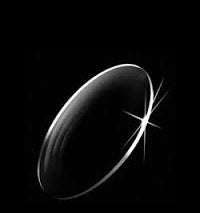If you would like to replace the lenses on your existing frame, please send us the frame. We will make it with the same frequency.
If you wish to change the lens power, please let us know the lens power.
[SA-1.67AS COMPLETE UV420-FR]
▼Specifications
・Design: Spherical design
・Material: High refractive plastic
・Refractive index: 1.67
・Abbe number: 32
・UV cut: UV420
・Coat: FR fresh coat (super water repellent)
▼Lens PRICE (1 set of 2 lenses)
・FR (super water repellent coat): 9,000 + TAX
In the past, the importance of protecting the eyes from ultraviolet (UV) radiation has become widely known. However, recent research shows that 400-420nm HEV (High Energy Violetlight) also causes significant damage to retinal tissue and is considered to be one of the causes of cataracts and age-related macular degeneration. This wavelength range was only cut down to 400nm with achromatic eyeglass lenses.
What is blue light retinal disorder?
The photochemical mechanism that causes blue light retinal damage is caused by light absorption by the eye's photoreceptors.
Under normal conditions, when light is applied to photoreceptors, the cells become cloudy, and their function as photoreceptors is restored through a metabolic process called the visual cycle of vision.
However, it has been reported that when a large amount of blue light is absorbed, cells become cloudy and then deteriorate again before functioning.
This greatly increases the potential for oxidative damage to retinal cells. By this mechanism, long-term exposure to even modest levels of ultraviolet radiation or short wavelengths can cause irreversible changes in biological tissues such as the skin, the lens of the eye, and especially the retina. may indicate.
HEV (High Energy Violetlight) (400nm to 420nm), which has the shortest wavelength of light that reaches the retina, is most likely to cause retinal damage.
Additionally, even if it is not enough to be considered a disorder, transient stimulation of retinal cells is thought to be a cause of eye strain.
(Reference: “Retinal photodamage caused by blue light” Toshihiko Ueda, Ophthalmology Account, Showa University School of Medicine)
Features of COMPLETE UV
1. Reduces glare
Light that enters our eyes is scattered by the crystalline lens. This scattered light causes glare. Blue light in particular has a special feature that scatters strongly among visible light, so cutting out this scattered light reduces glare.
2. You will be able to see clearly
Light that enters our eyes forms an image on the retina inside the eye, and the focal length differs slightly depending on the wavelength of the light.
This is chromatic aberration. The shorter the wavelength (red, yellow, green, blue), the closer the light will be focused in front of the retina.
This is one of the reasons why images appear blurry even though the prescription of your glasses is correct. By cutting out blue light, it reduces chromatic aberration and ensures clear vision.
3. Reduces irritation to the retina
Among the light that reaches the retina, HEV (High Energy Violetlight) has the second shortest wavelength after ultraviolet light (UV) at 400 nm to 420 nm. Reduces eye irritation by suppressing wavelengths of light that are highly irritating to the eyes. HEV is also considered to be one of the causes of age-related macular degeneration. By reducing the impact of short-wavelength visible light on the retina, it can also be expected to be effective in preventing macular degeneration and cataracts.
*Light sources including HEV
Many natural and artificial light sources contain HEVs. Not only light that appears blue, but light that appears white equally contains HEV.
·Sun light
・Blue LED
・White LED
·Halogen lamp
・Fluorescent light
・Incandescent light bulb
・Mercury lamp etc.




















